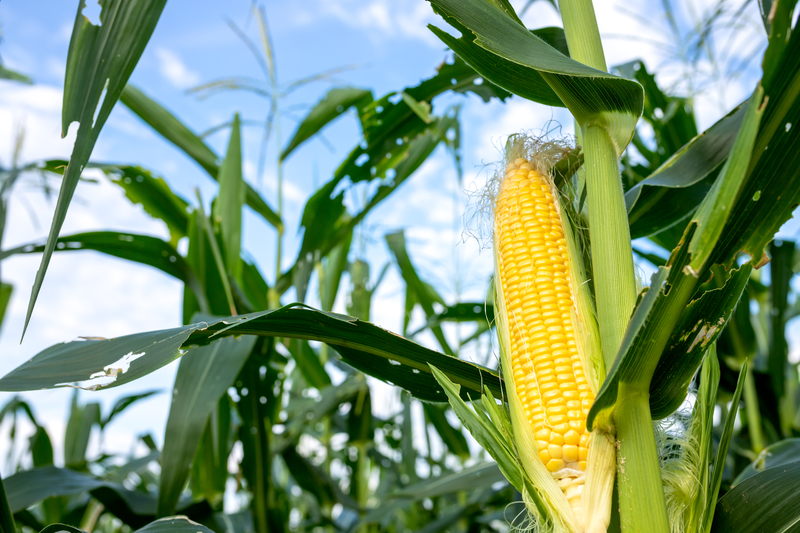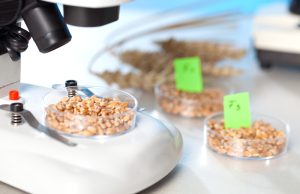
More than 90% of U.S. corn is genetically engineered. The majority is used for animal feed and ethanol production, while less than 2% is sold in grocery stores. Credit: Pramote Polyamate|Dreamstime.com.
The rise of genetically engineered (GE) seeds in U.S. agriculture has been a game changer, especially for the “corn belt” of Midwestern states and parts of the South: Here, the market share of GE corn grew rapidly from 25% in 2000 to 92% in 2022. These seeds were primarily developed to reduce the chance of crop infestation, through genes conferring greater insect resistance, and to protect crops from weed killers, through improved herbicide tolerance.
These efforts achieved their goal of boosting agricultural productivity, but AAE professor Guanming Shi noticed that a key piece of information was missing. “Few researchers had studied if and how environmental stressors may change the effects of GE seeds on average yields and their stability over time,” says Shi. “Accounting for this potential effect modification provides a more complete assessment of the impact of transgenic technology on U.S. agriculture.”
To study this question, Shi teamed up with Qinan Lu (AAE PhD’23) and fellow AAE professor Corbett Grainger. The researchers chose ground-level ozone as an environmental stressor since some corn hybrids were more sensitive than others to high ozone exposure in experimental trials. Whether or not this was also true in real-world corn fields had not yet been determined.
While atmospheric ozone high above Earth’s surface protects us from ultraviolet radiation, ground-level ozone can be harmful for humans, animals and plants. It is a secondary air pollutant formed when chemical emissions from industrial plants and vehicles react with sunlight, primarily during warm and sunny summer days. When ozone reacts with chemicals in plant cells, it can cause leaf injury and reduce photosynthetic activity, which gives plants the building blocks and energy to grow.
The researchers combined 20 years of data for 2,260 corn-growing counties from three different sources. First, the U.S. Department of Agriculture provided annual county-level corn yields from 2003 to 2022. The majority of U.S. corn (75-85%) is used for animal feed and ethanol production. Exports account for 15-20%, leaving less than 2% for human consumption.
Second, satellite systems provided data on ozone, temperature, precipitation, wind speed and wind direction. The researchers used the weather and ozone information to calculate two measures of interest for each county and year: growing degree days, defined as the number of days between the last spring frost and first fall frost; and an ozone exposure index for the county’s geographical midpoint. The study region’s average ozone level during the growing season was 49 parts-per-billion (ppb).
Third, the team predicted each county’s GE adoption rates from annual farmer surveys conducted by a commercial company. The combination of the three data sources provided almost 50,000 records. The researchers used a statistical analysis model that estimated a causal relationship between ozone levels, GE adoption rates and the average corn yield. But that average was not the only statistic of interest.
“Our earlier experimental study found that GE corn had a greater effect on the yield distribution risk than average yields, meaning that it reduced yield variation and the probability of extreme outcomes,” says Shi. “That is a very important benefit for farmers, who greatly value stability and certainty: Unusually low yields reduce their income while unusually high yields are difficult to store and sell as most contracts are based on typical production levels.”
The real-world data analysis confirmed the risk distribution benefits of GE corn. However, ozone exposure changed the impact of GE seeds with improved insect resistance (IR) on crop yields. For example, a 2.2 ppb increase in ozone levels reduced crop yields by 6.4% and 18.5% when IR seeds were planted in 32.5% and 100% of county fields, respectively. Ozone exposure had no effect on GE seeds with improved herbicide tolerance. This suggests that IR seeds may contain genes that “hitchhiked” with the desired genes and inadvertently made the seeds more vulnerable to ozone pollution.
The financial implications were significant: When all corn fields used IR seeds, a 2.2 ppb increase in ozone levels caused a monetary loss of $17.6 billion, or 18.5% of the total U.S. corn income in 2020. That number was $6.1 billion at the minimum IR seed adoption rate of 32.5%.

These results imply that GE seeds, despite their proven benefits for agricultural risk distribution, require further study. The negative effect of ozone on corn yield was only apparent during the reproductive phase, when the plant develops tassels, ears and kernels, not during the vegetative growth phase, when it produces leaves, stalks and roots. This helps agronomists delve into the biological mechanism behind the greater ozone sensitivity of GE corn, which could help develop more resilient hybrids.
Knowing that corn is most vulnerable during its reproductive phase is also useful for farmers, who can reduce emissions of ozone precursors on sunny days. For example, they can avoid burning crop residue in fields and limit fertilizer applications and the use of farm machinery. Long-term adjustments include the adoption of sustainable practices that permanently lower such emissions.
“Last but not least, our results also have implications for countries that are still experiencing an increase in GE adoption rates, such as Argentina and Brazil,” says Shi. “Policymakers in these countries should consider their own environmental conditions to better understand the impact of transgenic technology on national agricultural productivity.”